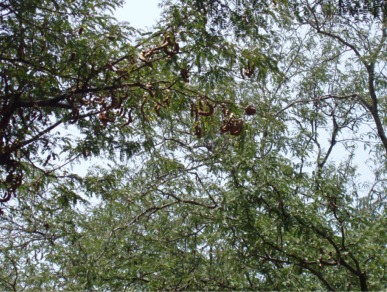Tamarind


Tamarind Fruits Tamarind Tree
The Tamarind (Indian date) is a tropical tree found in South India and Sri Lanka in plenty. The fruit pulp is edible and popular. It is used as a spice in both Asian and Latin American cuisines, and is also an important ingredient in a tamarind based sauce from Andhra Pradesh in India, Worcestershire sauce and HP sauce. The hard green pulp of a young fruit is very tart and acidic and is most often used as a component of savoury dishes. The ripened fruit is sweeter, yet still distinctively sour, and can be used in desserts and sweetened drinks, or as a snack. In Thailand, there is a carefully cultivated sweet variety with little to no tartness grown specifically to be eaten as a fresh fruit. Tamarind is a staple in Andhra Pradesh and Tamil Nadu diet, where it is used to prepare Rasam, Sambar and various types of chutneys. In Egypt, there is an acidic chilled drink made from tamarind which is popular in summertime. It is called "tamr hindi". Tamarind is available in specialty food stores worldwide in pod form or as a paste or concentrate.
General uses:
In temples, especially in Asian countries, the pulp is used to clean brass furniture, removing dulling and the greenish patina that forms. The tamarind wood is a bold red colour. Due to its density and durability, tamarind heartwood can be used in making furniture and wood flooring. A tamarind twig is sometimes used as an implement for corporal punishment. Tamarind trees are very common in Yarlpanam, South India, particularly in Tamil Nadu and Andhra Pradesh. They are used as ornamental trees and to provide shade on the country roads and highways. Tamarind is extensively used in the cuisine of these places.
Culinary Uses:
Usually it is the juice or paste that is used as a souring agent, particularly in south Indian and Yarlpanam dishes, curries and chutneys, where its flavour is more authentic than vinegar or lemon juice. Used in the making of fish dishes and Rasam in Jaffna. Tamarind contains pectin which is used in the manufacturing process of commercially produced jams, so it is a natural ingredient in many jams, jellies, fruit drinks a refreshing drink made from tamarind syrup and resembling lemonade is quite popular in the Middle East. In Yarlpanam, where there are no refrigeration facilities in the homes, people boil fish in tamarind syrup and other ingredients and this keeps well for the next day when it can be converted to a delicious curry. It is also another ingredient in Rasam in Yarlpanam.
Medicinal Uses:
Tamarind is considered a mild laxative and digestive. It is used to treat bronchial disorders and gargling with tamarind water is recommended for a sore throat. It is antiseptic, used in the treatment of ulcers. The pulp, leaves, and bark also have medical applications. For example, in the Philippines, the leaves have been traditionally used in herbal tea for reducing malaria fever. Due to its medicinal value, tamarind is used as an Ayurvedic Medicine for gastric and/or digestion problems.





